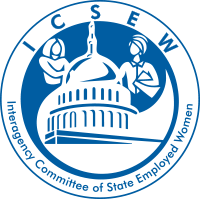Here's What We're Actually Celebrating on Women's Equality Day

College suffragists picketing the White House, circa 1917. Photo from the Library of Congress on Wikemedia Commons.
Editor’s Note: August 26 is Women’s Equity Day. The ICSEW is hosting its annual Professional Development Conference August 27. Is your agency hosting an event for Women’s Equality Day? Tell us about it: icsew@ofm.wa.gov
This article was originally published on forutune.com in 2017.
We’ve already marked a few women’s holidays this year—including International Women’s Day (March 8) and Equal Pay Day (April 4)—so you’re well within your rights to wonder what exactly we’re celebrating on Women’s Equality Day this Saturday, Aug. 26.
While the U.S. has no shortage of questionable holidays (hello, National Rum Day), Women’s Equality Day is a vitally important day for roughly half of the country’s population, with real roots in American history. Here’s everything you need to know:
Women’s Equality Day celebrates the 19th Amendment
The holiday is not about “celebrating” women in general. It’s about commemorating women’s history and, in particular, the passage of the 19th Amendment, which gave (most) women the right to vote. The amendment is deceptively simple. It reads:
The right of citizens of the United States to vote shall not be denied or abridged by the United States or by any State on account of sex. Congress shall have power to enforce this article by appropriate legislation.
Suffragettes lobbied for a woman’s right to vote
Before the 19th Amendment was passed, no woman had the right to vote. Women’s suffrage—or the political fight to enfranchise women—is widely considered to have begun with the Seneca Fall convention, as chronicled by this U.S. House’s Office of the Historian. During this gathering, which was held in Seneca Falls, N.Y. in 1848, organizers drafted a “Declaration of Sentiments, Grievances, and Resolutions” that echoed the preamble of the Declaration of Independence: “We hold these truths to be self-evident: that all men and women are created equal.”
From there, several women—including, at various times, Elizabeth Cady Stanton, Lucretia Mott, Susan B. Anthony, Alice Paul, and Carrie Chapman Catt—led the charge in lobbying Congress and the White House on behalf of American women.
The tipping point came in 1917, when President Wilson made the decision to enter World War I. Suffragettes argued that the effort to “make the world safe for democracy” (Wilson’s words) ought to begin at home by extending the franchise. Moreover, they insisted, the failure to extend the vote to women might hinder their participation in the war effort—which was direly needed.
After a lengthy legal process (changing the Constitution is no small feat!), the Amendment was ratified on Aug. 26, 1920.
The 19th amendment vs the Voting Rights Act
Even after the Amendment’s ratification, millions of women (and men)—most significantly black Americans, but also many immigrant women of Chinese, Mexican, and Native American descent—were disenfranchised, thanks to literacy tests and other voter suppression mechanisms. It wasn’t until the 1965 passage of the Voting Rights Act that all Americans were truly guaranteed the right to vote. (Some historians take issue with that date, arguing that it wasn’t until a 1975 extension provided for bilingual ballots that suffrage became truly universal.)
Subscribe to the Broadsheet, Fortune’s daily newsletter on powerful women.
Women’s Equality Day is widely recognized, but not official
In 1971, a year after the Women’s Strike for Equality March—during which 50,000 women marched down New York City’s Fifth Avenue demanding changes to childcare and abortion policies—Congress passed a resolution designating Aug. 26 as Women’s Equality Day. The law, which was first introduced by Congresswoman Bella Abzug, technically states that the president is “authorized and requested to issue a proclamation in commemoration of that day in 1920 on which the women in American were first guaranteed the right to vote.”
While every president from Richard Nixon to Barack Obama has proclaimed Aug. 26 as Women’s Equality Day, the law does not require the president do so. This differentiates the day from official federal holidays, which are designated by Congress.
Resources
National Women’s History Day Alliance: https://nationalwomenshistoryalliance.org/resources/commemorations/womens-equality-day/10-ideas-for-womens-equality-day/
Washington State Historical Society 2020 Suffrage Centennial:
http://www.washingtonhistory.org/research/suffrage100wa/

